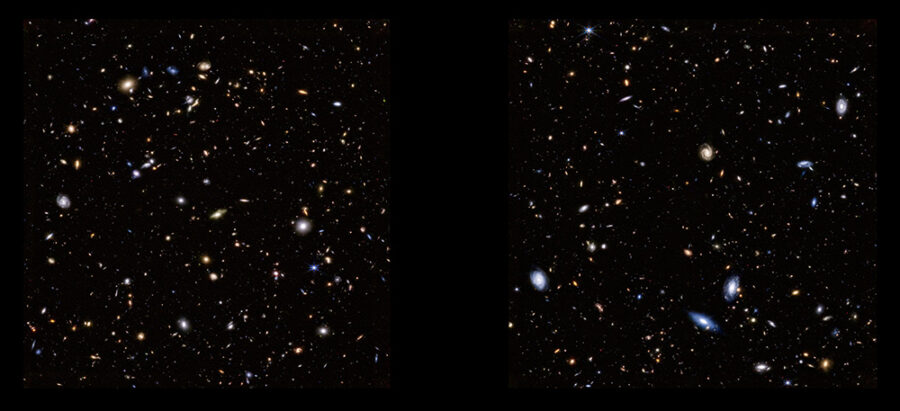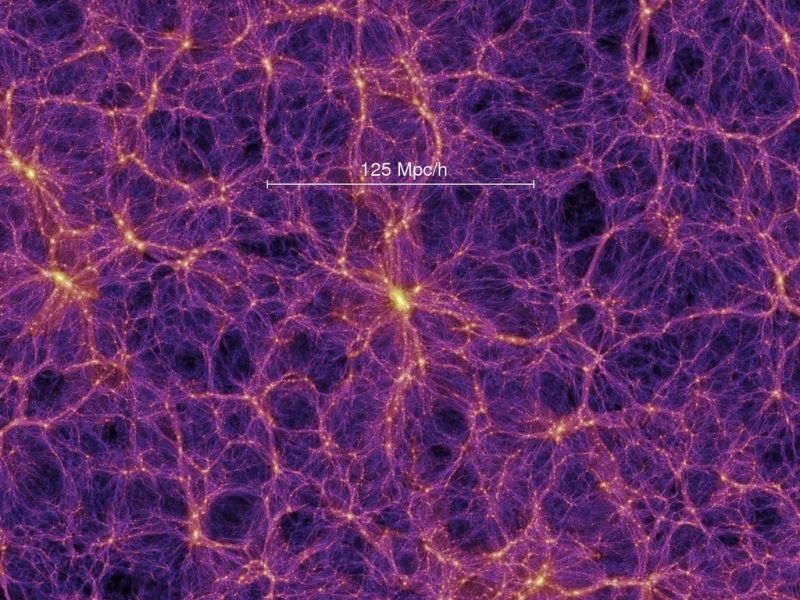
Astronomers have used the James Webb Space Telescope (JWST) to reveal a host of high-mass galaxies in the early universe — but according to a new study they shouldn’t really exist. Either astronomers have misunderstood something about the galaxies themselves, or our leading model of cosmology is called into question.
Despite being in space less than 18 months, JWST is already providing unprecedented views of the universe in the first few hundred million years after the Big Bang. A big surprise has been how quickly large, star-filled galaxies appeared.
Now, Michael Boylan-Kolchin (The University of Texas, Austin) has looked at the problem from another angle, publishing his findings in Nature Astronomy. The leading cosmological model is known as ΛCDM, where CDM stands for cold dark matter. According to the model, ordinary matter and dark matter were well mixed in the early universe. When dark matter haloes collapsed to form the first galaxies, some of the mixed-in ordinary matter turned into new stars.

“We have very good evidence of the distribution of matter in the early universe from the cosmic microwave background,” Boylan-Kolchin says. He calculated how much of the ordinary matter would need to end up in stars to account for the JWST high-mass galaxies. “Almost every available atom would have been used to make stars,” he says.
According to Boylan-Kolchin, this near 100% efficiency is borderline impossible. “It’s more like 10% in the modern universe,” he says.
“The theoretical analysis in this paper is very sound,” says Mark Vogelsberger (MIT), who was not involved in the research. “There are not many assumptions going into the calculation, which renders the results very robust.”
So if Boylan-Kolchin’s sums are right, does that mean ΛCDM is wrong? He isn’t quite ready to dispense with it just yet. “No other theory can do what it does — it would be a last resort to overthrow it,” he says.
What else could be going on? A team led by Hayley Williams (University of Minnesota) has just announced the discovery of an intriguing early galaxy at redshift 9.5, also using JWST. It’s so faint that it can only be seen thanks to amplification by gravitational lensing. Williams found that the galaxy has a star formation rate some 38 times higher than a galaxy at redshift 8. The results are published in Science.
“This galaxy has a much lower mass than the galaxies discussed [by Boylan-Kolchin] but, if this kind of star formation can also happen in higher-mass galaxies at similar redshifts, it could help explain the tension with the standard cosmological model,” she says.
Boylan-Kolchin isn’t so sure, because this object is just 53 light-years across. Galaxies are normally thousands of times bigger. “It could be a globular cluster instead,” Boylan-Kolchin says.
There are some other options for resolving the tension, like tweaking ΛCDM. A family of theories known as Early Dark Energy (EDE) models suggest altering the behavior of dark energy (the Λ in ΛCDM) immediately after the Big Bang. Doing so would help resolve another ongoing debate surrounding the Hubble constant. Squaring this with other observations would require extra matter in the early universe. Boylan-Kolchin calculates that the density of matter in early galaxies would have been 3 times higher in this case, meaning star formation wouldn’t need to be as efficient to provide the same result. However, EDE models also suggest that the universe is only 13 billion years old, which is in conflict with other measurements.
Astronomers could also be mistakenly attributing some of the galaxies’ light to stars, when in fact it is coming from accretion disks around supermassive black holes. “This is one of the most likely scenarios,” Boylan-Kolchin says.
So far astronomers have only seen a handful of these galaxies, and they are all in an area that takes up just a quarter-millionth of the sky. That’s hardly representative of the whole cosmos. “We may well find with follow-up full statistical surveys . . . that this tension disappears,” says Joel Leja (Penn State), who was not involved in the research.
They might not even be distant galaxies at all. “Nearby, low-mass galaxies can mimic the appearance of distant, massive galaxies,” says Peter Behroozi (University of Arizona), also not involved in Boylan-Kolchin’s work. “No-one can reliably [say] whether the conclusions of this paper are right or wrong until more measurements are taken.”
What’s really needed are spectroscopic measurements of these galaxies. That will help iron out their true distance and allow astronomers to look for signs of black holes. The good news is that this data is on the way. “We really should know if this a serious problem within a couple of years, maybe less,” Boylan-Kolchin says.








